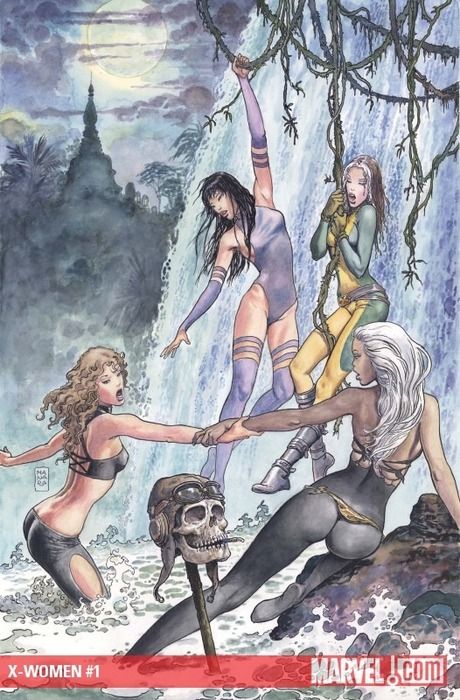The relationship between pornography and comics has, historically, been thinner than many people would openly admit. From the light-bondage inherent in Wonder Woman's creation to the frequent themes domination and submission in Chris Claremont's X-Men run, to the pornographic work of Joe Shuster and Bill Willingham, psychosexual imagery is never a million miles away from the superhero industry. Its influence can be easily seen in just about any title on the shelves.
That goes double for "X-Women #1", a book drawn by Milo Manara, an artist notorious for his pornographic works. The book has, not unreasonably, ignited people's passions in more ways than one. For some, it's an exploitative, needlessly titillating comic. For others, it's a rare chance to see a master of his craft draw some of their favorite characters. Personally, I think it's a little of both.
I'll say right now that I consider myself a feminist. I believe strongly that society needs to work towards equal rights for women, and that the comics industry needs to work twice as hard just to catch up with society. However, I'm also a fan of Milo Manara. Not because he draws women like sexual objects, but because I think he is, without a doubt, a complete master of the comics form. He's a man with the chops to rival greats like Moebius and Frank Quitely. He does not, as I have seen some commentators charmingly suggest, "make Greg Land look good." Unlike Greg Land, Manara has an understanding of things like composition, storytelling and, yes, the human body.
That's not to say I don't understand why there's a certain amount of outrage over this book. Perhaps if I'd never encountered Milo Manara before, I'd struggle to understand why Marvel felt it appropriate to work with him. However, one difference worth noting between Manara's artwork and the vast majority of current superhero artists is that Manara strives for a physical ideal that could actually exist. The backs may be arched, the mouths may be slackened, but the spines are far from dislocated and the expressions far from glassy. Manara's characters are in-proportion. They move and exist in real space. For possibly the first time ever, Psylocke is depicted as visibly Asian, rather than as a white woman with slightly Asian eyes and skin tone. There is simply no denying that Manara knows how to draw, and how to tell a story.
That's not to say the book doesn't have its problems. There are scenes and images Manara chooses to draw that do make me uncomfortable. It is, at times, little more than porn. But, then, that phrase seems like a loaded one. Alan Moore -- undoubtedly one of the greatest writers this industry has even seen, and a man who I have witnessed first-hand demonstrating his astounding grasp of feminist theory -- wrote "Lost Girls", a book which he openly admitted was porn. I'd like to hear the ways in which "X-Women" is any worse than that.
As it is, I see no hypocrisy in the notion that you can be a feminist and appreciate Manara's work, and indeed, that you can be a feminist and believe there's a place in society for pornography and erotic work of any kind. You can disagree with Manara's individual choices while still respecting his craft. Perhaps there probably are people who will buy "X-Women" purely for the chance to see Psylocke's scantily-clad form. But then, there are people who buy "X-Men" for that reason already. I'd probably argue that keeping Manara off the shelves would have served no greater agenda.
At this point, I feel as though the review should actually get around to discussing the comic itself, but I do think the points made thus far are important ones, crucial to the reading of the book. As a display of artistry, "X-Women" is undeniably fantastic. As a piece of entertainment, though, it's merely okay. There are some great character moments that hint at quite how good this comic could have been, but they are far and few between. With Claremont's plot returning to well-trodden "mutants losing their powers" ground, and his dialogue and narration as over-written as usual, it never quite gets going in the way it should. Forget the gratuitous imagery. The real way in which this comic does the female X-Men members a disservice is by failing to give them an adventure truly worthy of their time -- or, indeed, of Manara's.

